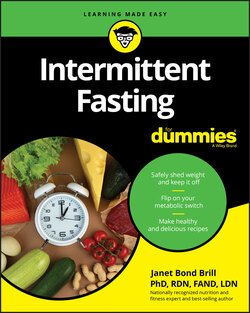Читать книгу Intermittent Fasting For Dummies - Janet Bond Brill - Страница 49
Burning calories through exercise
ОглавлениеThe burning of calories through physical activity, combined with reducing the number of calories you eat, creates the magical calorie deficit that results in weight loss. You need to consciously make an effort to move more during your days, an action that will make a dent in your NEAT. NEAT is essentially movement you do that isn’t formal exercise, such as cleaning the house, shopping for groceries, or even just fidgeting. Take the stairs over the elevator, park farther away from the store, stay away from drive-throughs, and stand more and sit less. All these seemingly small physical efforts add up and can make a huge contribution to your calorie burn. Become a NEAT freak and boost your daily calorie burn!
With planned exercise, or your EAT, your goal should be to find an exercise that you enjoy doing, one that will burn a few hundred daily calories. The number of calories your body burns during exercise depends again on your height, weight, age, body composition, and a bunch of other factors. The calories burned, such as the number that pops up on an exercise machine, is at best a very broad (and very imprecise) estimate.
If you’re curious about how many calories you burn during different types of exercise, you can estimate your calorie expenditure by using a simple online calculator. The Calorie Control Council website has a Get Moving Calculator at https://caloriecontrol.org/healthy-weight-tool-kit/get-moving-calculator that allows you to get into the nitty-gritty of what a realistic amount of exercise-and therefore potential calorie burn-is for you and you alone (genius idea):
Consider Kiki’s numbers. Kiki weighs 150 pounds. Plug her data into the online calculator and magically see how many calories she burns during her 30-minute dog walk at a moderate pace: 102 calories per walk. If Kiki were to walk her dog every day for 30 minutes (instead of just three times per week) she would make a considerable contribution to her weekly calorie deficit; she’d burn approximately 700 calories a week from her daily walk instead of approximately 300. The moral of the story is that exercise can make a difference in the calorie burn side of the equation. Find an exercise that you’ll do preferably every day of the week. No marathons required! Flip to Chapter 14 if you want an additional primer on the best types of exercise to accompany your intermittent fasting plan.
If you plan on adding a new exercise, you can certainly run it through the formula. At this point, however, if the thought of adding a new exercise and practicing intermittent fasting all at once is too difficult, then don’t. Focus instead on the doable goals of being more active, eating healthy, and sticking to your intermittent fasting schedule. Over time, after you get the intermittent fasting lifestyle under your belt, you can concentrate more on boosting the calorie burn side of the equation.
